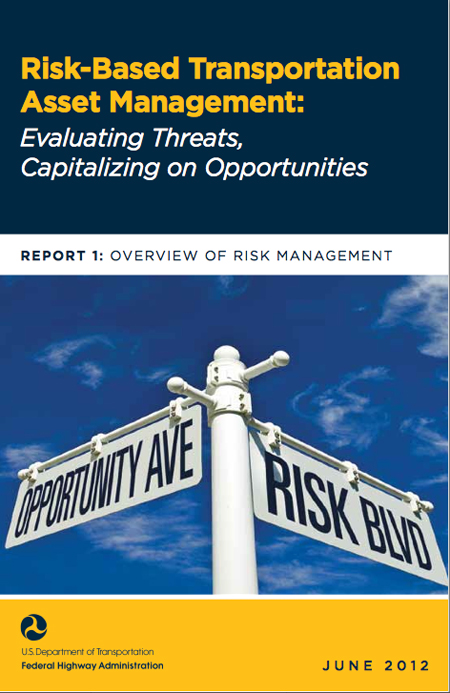U.S. Department of Transportation
Federal Highway Administration
1200 New Jersey Avenue, SE
Washington, DC 20590
202-366-4000
Focus
| Accelerating Infrastructure Innovations |
Publication Number: FHWA-HRT-14-012
Date: April 2014
Printable Version (.pdf, 0.3 mb)
A new series of reports available from the Federal Highway Administration (FHWA) examines how transportation agencies can use risk management to better protect their highway infrastructure investments, improve decisionmaking, and demonstrate accountability.
Until recently, transportation agencies have largely used risk management at the project level during construction. Managing risks at the project level helps to identify threats to the cost, scope, and schedule, as well as opportunities to keep projects on track. However, risk management can also pay dividends at the broader program and organizational levels, particularly when agencies face funding challenges. For example, the Washington State Department of Transportation (WSDOT) tracks and forecasts potential risks to assets. Based on the classification, age, condition, performance, and projected risk to assets, WSDOT then develops and implements reconstruction and preservation strategies. Agencies can also use risk management to prepare for and respond to such external risks as extreme weather events, climate change, and major economic downturns.
Managing risk is an integral step in following a comprehensive asset management framework, as described in the American Association of State Highway and Transportation Officials Asset Management Guide-A Focus on Implementation. And under the Moving Ahead for Progress in the 21st Century Act (MAP-21), States are to develop risk-based transportation asset management plans.
State transportation agencies with a process for undertaking a risk management analysis for their highway network would include identification, assessment, evaluation, and prioritization of risks that can affect the condition, effectiveness, and system performance as it relates to operation of their physical assets. Agencies would also include an approach for addressing the risks that they determine to be high priority.
"This series of reports will help transportation agencies as they develop their asset management plans and make complex infrastructure investment decisions and communicate them effectively to the public," said Steve Gaj of FHWA.
Five reports are available in the Risk-Based Transportation Asset Management series:
To download all of the reports, visit www.fhwa.dot.gov/asset/pubs.cfm?thisarea=risk. For more information on risk-based transportation asset management, contact Nastaran Saadatmand at FHWA, 202-366-1337 (email: nastaran.saadatmand@dot.gov), or Steve Gaj at FHWA, 202-366-1336 (email: stephen.gaj@dot.gov).
Investing in the Future of Pavement Management
As transportation agencies have changed the way they do business in recent years, including the increased use of asset management principles for resource allocation and other decisionmaking, the role of pavement management has changed also. Pavement management continues to evolve as it moves from reporting pavement condition, optimizing projects, and estimating funding needs to supporting asset management practices, linking maintenance and preservation activities, and providing performance data for calibrating the Mechanistic-Empirical Pavement Design Guide models and other performance-based models.
Data collection technologies have also evolved over the years, moving from visual pavement condition surveys to modern automated techniques. As data collection becomes more efficient, accurate, and precise, agencies can use the better quality data to make more informed decisions. This has become even more important in the face of shrinking funding, an aging pavement network, and increased traffic demands.
These advances in pavement management are fulfilling the vision of FHWA's Pavement Management Roadmap (Pub. No. FHWA-HIF-11-011). The Roadmap outlines research and development initiatives and priorities needed by the year 2020 to address the country's pavement management needs at the project, network, and strategic levels. To learn more about completed and ongoing projects, including research into new applications of pavement management data, strategies for incorporating emerging technologies into pavement management systems, and steps to achieving more sustainable pavement management, visit FHWA's Pavement Management Roadmap Web site at www.fhwa.dot.gov/pavement/management/roadmap.
